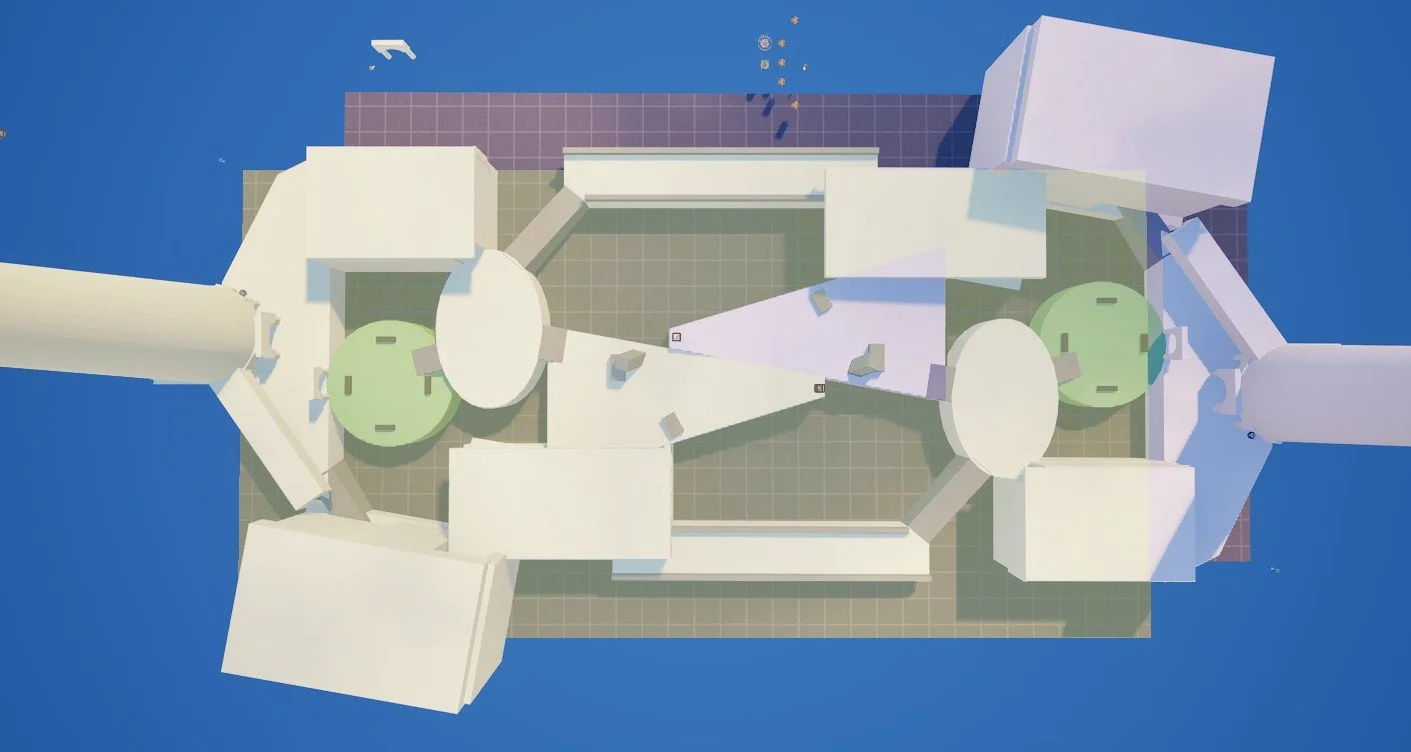Paint Rush
Paint Rush combines the thrill of high-speed racing with chaotic paint-fueled strategy in a rebellious underground world built by teenagers. Inspired by Mario Kart 8 Deluxe and Splatoon 2, players collect paint buckets and shoot different colored paints to alter the racetrack in real-time, speeding themselves up, slowing rivals, or jumping to new heights. Customizable racers, local multiplayer support, and creatively designed levels make every lap a wild ride. Players must learn to shoot paint wisely and master the terrain to claim victory in this bold, rule-bending racer.
Engine: Unreal Engine 5
Game Type: Kart Racer
Personal Project
5 Person Development Team
Roles and Responsibilities
Designed racetrack optimized for kart racing and paint-based gameplay
Defined areas for strategic paint deployment, traversal hazards, and movement-enhancing zones
Prototyped all core mechanics in Unreal Engine 5 using Blueprints, including paint effects, kart physics, and power-ups
Implemented color-coded paint zones that trigger unique effects such as speed boosts, traction loss, or projectile slowdown
Created interactive environment elements like boost pads, paint pickups, and splatter surfaces
Built modular track sections to support iteration and scalability in level design
Authored a comprehensive Level Design Document (LDD) outlining lap structure, item placement strategy, and visual theming
Balanced gameplay by playtesting paint effects and adjusting kart responsiveness and item frequency
Bubble Diagram of Top Down Layout of Map
Level Design Process
Metrics-Driven Iteration
Created a detailed Level Design Document (LDD) to guide development. Included environment concepts, character/object metrics, layout diagrams, and gameplay flow.
Used player movement data (run speed, jump distance, sightlines) to define traversal paths, combat zones, and item placements.
Designed mirrored sides with different architectural styles (elegant vs. menacing) to support team identity and clarity while maintaining mechanical symmetry.
Greyboxing & Blockout
The design began with greyboxing in UEFN using built-in modeling tools to rapidly prototype layout ideas.
Early versions used open node-based zones, but this felt unnatural during playtests—players lacked spatial anchors, and flow felt disconnected.
Pivoted toward a more cohesive blockout approach where structures and forms from Barad-dûr and Minas Tirith organically merged, creating a grounded yet fantastical battleground.
Mid-Map Redesign & Risk-Reward Spaces
After several test sessions, I reworked the central bridge into a curved cliff area.
This change added verticality and a compelling risk-reward structure—players could climb to the high ridge for powerful gear (Rocket Launcher, Chug Jug) but faced high exposure from all sides.
Gameplay Element Integration
Health, shield potions, and weapons were placed to reinforce pacing and encourage movement through the map.
High-value items were positioned in exposed or difficult-to-reach spots to reward aggressive or skilled players.
Playtesting & Loop Refinement
Conducted multiple rounds of internal and peer playtesting, focusing on flow, engagement hotspots, and pacing.
Made iterative tweaks to item locations, sightlines, and lane structure based on player behavior and feedback.
Parti Diagram of Mintis Tirith Mirrored and Rotated
This was developed to get an idea of the shapes and paths that appear when flipping and mirroring one side of the map. The left side would later be replaced with Barad-dur structures but have the same overall shapes.
Problem Solving
The level began with a greybox layout built using UEFN’s modeling tools. My initial approach followed a bubble diagram structure, outlining separate zones for combat, traversal, and objectives. While helpful for early planning, this setup felt disconnected and unnatural during playtests. Movement lacked flow, and areas didn’t blend together in a satisfying way.
To fix this, I transitioned to a more integrated design, where buildings and structures from Minas Tirith and Barad-dûr overlapped and merged. This created a more cohesive map with better flow and visual storytelling, while still preserving mechanical symmetry.
The central area also posed issues—early versions were too flat and unengaging, offering little incentive or risk. I redesigned it into curved cliffs, introducing verticality and risk-reward gameplay. Powerful items like the Rocket Launcher and Chug Jug were placed at the top, making it a high-risk, high-reward zone exposed from all angles.
Finally, the base areas were initially too open, leaving defenders vulnerable and slowing gameplay. I solved this by adding strategic obstacles that block sightlines, offer cover, and create more dynamic traversal paths, enhancing both defense and movement options.
Initial blockout version showing disconnected zones—lacked spatial cohesion and fluid player movement.
Refined greybox – overlapping architecture and layered design brought the map to life with smoother transitions and natural player paths.






